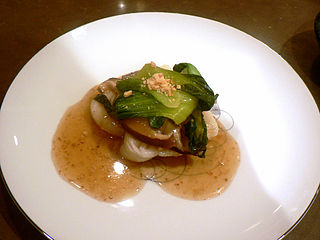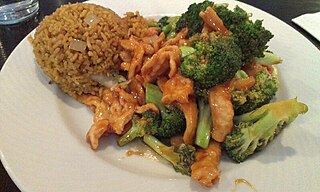 | |
| Type | Stir fry |
|---|---|
| Course | Main course |
| Region or state | United States of America |
| Associated cuisine | American Chinese cuisine |
| Main ingredients | Beef, broccoli |
Beef and broccoli, also sometimes called broccoli beef, is an American Chinese dish.
 | |
| Type | Stir fry |
|---|---|
| Course | Main course |
| Region or state | United States of America |
| Associated cuisine | American Chinese cuisine |
| Main ingredients | Beef, broccoli |
Beef and broccoli, also sometimes called broccoli beef, is an American Chinese dish.
Beef and broccoli was likely developed in the diaspora of Chinese immigrants in 19th century America. [1] It had become an established feature of American Chinese restaurants during the 1920s. [2] By the 1950s it had become ubiquitous and is now one of the most popular American Chinese dishes. [3] It is based on a Chinese dish that used gai lan, but this was replaced with broccoli, [4] [5] which had been popularized in the United States by Italian immigrants. [6]

The dish is prepared by stir frying sliced steak and broccoli florets with oyster or soy sauce and aromatics such as garlic and ginger. Sugar or honey may be used to sweeten the sauce. [7] Corn starch is commonly used to tenderize the beef and thicken the sauce. [8] [9]

American Chinese cuisine is a cuisine derived from Chinese cuisine that was developed by Chinese Americans. The dishes served in many North American Chinese restaurants are adapted to American tastes and often differ significantly from those found in China.

Chow mein is a Chinese dish made from stir-fried noodles with vegetables and sometimes meat or tofu. Over the centuries, variations of chǎomiàn were developed in many regions of China; there are several methods of frying the noodles and a range of toppings can be used. It was introduced in other countries by Chinese immigrants. The dish is popular throughout the Chinese diaspora and appears on the menus of most Chinese restaurants abroad. It is particularly popular in India, Nepal, the UK, and the US.

Laab / Larb is a type of Lao meat salad that is the national dish of Laos, along with green papaya salad and sticky rice. Laab in the Lao language means "lucky" or it is a noun which refers to the meat or other flesh which has been finely chopped and pounded. Laab is of Lao origin, but is also eaten in other regions, most prominently the neighboring former Lan Xang territory, or modern day Laos and the northeastern and northern areas of Thailand, Isan and Lanna where the Lao have extended their influence. Other local variants of laab also feature in the cuisines of the Tai peoples of Shan State, Burma, and Yunnan Province, China.

Pad thai, phat thai, or phad thai, is a stir-fried rice noodle dish commonly served as a street food in Thailand as part of the country's cuisine. It is typically made with rice noodles, shrimp, peanuts, a scrambled egg, and bean sprouts. The ingredients are fried in a wok.

Fried rice is a dish of cooked rice that has been stir-fried in a wok or a frying pan and is usually mixed with other ingredients such as eggs, vegetables, seafood, or meat. It is often eaten by itself or as an accompaniment to another dish. Fried rice is a popular component of East Asian, Southeast Asian and certain South Asian cuisines, as well as a staple national dish of Indonesia. As a homemade dish, fried rice is typically made with ingredients left over from other dishes, leading to countless variations. Fried rice first developed during the Sui Dynasty in China.

Gai lan, kai-lan, Chinese broccoli, or Chinese kale is a leafy vegetable with thick, flat, glossy blue-green leaves with thick stems, and florets similar to broccoli. A Brassica oleracea cultivar, gai lan is in the group alboglabra. When gone to flower, its white blossoms resemble that of its cousin Matthiola incana or hoary stock. The flavor is very similar to that of broccoli, but noticeably stronger and slightly more bitter.

Cashew chicken is a Chinese-American dish that combines chicken, with cashew nuts and either a light brown garlic sauce or a thick sauce made from chicken stock, soy sauce and oyster sauce.

Jajangmyeon (Korean: 자장면) or jjajangmyeon (짜장면) is a Chinese-style Korean noodle dish topped with a thick sauce made of chunjang, diced pork, and vegetables. It originated in Incheon, Korea where Chinese migrant workers started making zhajiangmian in the late 19th century. Modifications in Korea such as a darker and sweeter sauce differentiate the Korean version from the Chinese dish. Variants of the dish use seafood, or other meats.

Moo goo gai pan is the Americanized version of a Cantonese dish – chicken with mushroom in oyster sauce (香菇雞片), which can be a stir-fry dish or a dish made in a claypot. The Chinese-American version is a simple stir-fried dish with thin sliced chicken, white button mushrooms, and other vegetables. The word pan 片 means thin slices, referring to the way the chicken is cut. Popular vegetable additions include bok choy, snow peas, bamboo shoots, shiitake mushrooms, water chestnuts, carrots, and/or Chinese cabbage.

Japanese Chinese cuisine, also known as Chūka, represents a unique fusion of Japanese and Chinese culinary traditions that have evolved over the late 19th century and more recent times. This style, served predominantly by Chinese restaurants in Japan, stands distinct from the "authentic Chinese food" found in areas such as Yokohama Chinatown. Despite this difference, the cuisine retains strong influences from various Chinese culinary styles, as seen in the Shippoku cooking style.

Pad see ew is a stir-fried noodle dish that is commonly eaten in Thailand. It can be found easily among street food vendors and is also quite popular in Thai restaurants around the world. The origins of the dish can be traced to China from where the noodle stir-frying technique was brought.

Drunken noodles or drunkard noodles is a Thai stir-fried noodle dish similar to phat si-io but spicier. In English texts, it is rendered as pad kee mao, pad ki mao, or pad kimao – from its Thai name Thai: ผัดขี้เมา, RTGS: phat khi mao,, in which phat means 'to stir-fry' and khi mao means 'drunkard'.

Mie goreng, also known as bakmi goreng, is an Indonesian stir-fried noodle dish. It is made with thin yellow noodles stir fried in cooking oil with garlic, onion or shallots, fried prawn, chicken, beef, or sliced bakso (meatballs), chili, Chinese cabbage, cabbages, tomatoes, egg, and other vegetables. Ubiquitous in Indonesia, it is sold by food vendors from street hawkers (warungs) to high-end restaurants.

Rat na, also written rad na, is a Thai-Chinese noodle dish. The name of the dish is pronounced in Thai colloquial speech.

Lard na is a Lao-Chinese noodle dish covered in gravy that was made popular as a street food by Chinese living in Laos.

Kwetiau goreng is an Indonesian style of stir fried flat rice noodle dish. It is made from noodles, locally known as kwetiau, which are stir fried in cooking oil with garlic, onion or shallots, beef, chicken, fried prawn, crab or sliced bakso (meatballs), chili, Chinese cabbage, cabbages, tomatoes, egg, and other vegetables with an ample amount of kecap manis. In Asia, kwetiau is available in two forms, dried and fresh. Its recipe is quite similar to another Chinese Indonesian favourite, mie goreng, with the exception of replacing yellow wheat noodles for flat rice noodles.

Wonton noodles is a noodle dish of Cantonese origin. Wonton noodles were given their name, húntún, in the Tang Dynasty. The dish is popular in Southern China, Hong Kong, Indonesia, Malaysia, Singapore and Thailand. The dish usually consists of egg noodles served in a hot broth, garnished with leafy vegetables and wonton dumplings. The types of leafy vegetables used are usually gai-lan, also known as Chinese broccoli or Chinese kale. Another type of dumpling known as shui jiao (水餃) is sometimes served in place of wonton. Shrimp wonton are mostly known as Hong Kong dumplings. The wontons contain prawns, chicken or pork, and spring onions, with some chefs adding mushroom and black fungus. In Indonesia especially in North Sumatra, West Kalimantan and South Sulawesi, wonton noodles are called mie pangsit.

Australian Chinese cuisine is a style of cooking developed by Australians of Chinese descent, who adapted dishes to satisfy local Anglo-Celtic tastes. Its roots can be traced to indentured Chinese who were brought to work as cooks in country pubs and sheep stations.

Chicken and broccoli, or broccoli chicken, is an American Chinese dish.